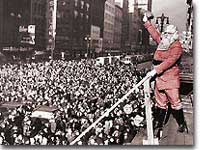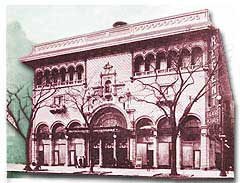46f. A Consumer Economy

Santa waves to children outside a department store during a Thanksgiving Day Parade.
The 1920s was a decade of increasing conveniences for the middle class. New products made household chores easier and led to more leisure time. Products previously too expensive became affordable. New forms of financing allowed every family to spend beyond their current means. Advertising capitalized on people's hopes and fears to sell more and more goods.
Changing Housework

The Regent Theater, America's First Movie Palace
By the end of the 1920s, household work was revolutionized. A typical work week for a housewife before the twenties involved many tedious chores. All the furniture was moved off the carpets, which were rolled up and dragged outside to beat out the week's dirt and dust. The ice in the icebox was replaced and the waterpan that lay beneath was repeatedly changed. The clothes were scrubbed in a washing tub on a washboard. An iron was heated on the stove to smooth out the wrinkles. Women typically spent the summer months canning food for the long winter. Clothes were made from patterns, and bread was made from scratch. Very few of these practices were necessary by the end of the decade. Vacuum cleaners displaced the carpet beater. Electric refrigerators, washing machines, and irons saved hours of extra work. New methods of canning and freezing made store-bought food cheap and effective enough to eliminate this chore. Off-the-rack clothing became more and more widespread. Even large bakeries were supplying bread to the new supermarkets. The hours saved in household work were countless.
Buying on Credit
"Buy now, pay later" became the credo of many middle class Americans of the Roaring Twenties. For the single-income family, all these new conveniences were impossible to afford at once. But retailers wanted the consumer to have it all. Department stores opened up generous lines of credit for those who could not pay up front but could demonstrate the ability to pay in the future. Similar installment plans were offered to buyers who could not afford the lump sum, but could afford "twelve easy payments." Over half of the nation's automobiles were sold on credit by the end of the decade. America's consumers could indeed have it all, if they had an iron stomach for debt. Consumer debt more than doubled between 1920 and 1930.
Advertising
Fueling consumer demand were new techniques in advertising. This was not a new business, but in the increasingly competitive marketplace, manufacturers looked to more and more aggressive advertising campaigns. One major trend of the decade was to use pop psychology methods to convince Americans that the product was needed. The classic example was the campaign for Listerine. Using a seldom heard term for bad breath — halitosis — Listerine convinced thousands of Americans to buy their product. Consumers might not have known what halitosis was, but they surely knew they did not want it.
Advertisers were no longer simply responding to demand; they were creating demand. Radio became an important new means of communicating a business message. Testimonials from Hollywood film stars sold products in record numbers.
The advertising business created demand for the gadgets and appliances being manufactured by American factories.





